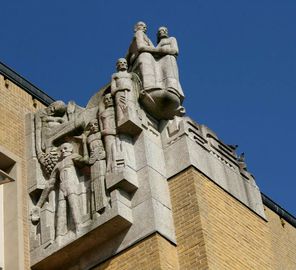

It is easy to see that the designers and the architects of the houses on this street really intended to make a complete work of art, creating a single architectural ensemble. The facades, the cornices, the slanted roofs, the mailboxes, the sculptures and reliefs and even the house numbering were fully integrated into the choreographed whole. This attention to details shows the special care and love for their work that the craftsmen brought to this project. Looking at the underside of the balconies, we can see they are lined with brick. Due to differences between concrete and brick, this took extensive care and time to accomplish. Symbolism was central to Amsterdam School decorations. Look up and on each side of the roof you will notice cast iron roosters, the mascot of the housing association that commissioned these projects. The roosters announce the dawn of anew age of energy and willpower, and are supposed to reference the awakened consciousness of the working class.
Anybody wandering around Amsterdam can’t fail to notice many bridges dating from the same era, adorned with stone sculptures and reliefs. The Lyceum Bridge on Apollolaanavenue is a good example in this neighborhood. HildoKrop, who lived in the middle of XX century, was the city sculptor behind many of these projects. He was inspired by industrialization and faith in the progress of the future, but also by themes like family and tradition. His work also sometimes betrays Egyptian influence. Two of his large-scale works can be seen on the two buildings of the Berlage Community School on both sides of the P. L. Takstraat. The sculpture entitled The Birth of Action (east side of the street) shows a woman’s head and a newborn baby, a tough figure of a man and a prancing horse, representing human tenderness, the will and the accomplishment, respectively. The man leading the horse represents the one who has understood and achieved the "happiness of the act". The sculpture on the western side of the street is entitled Human Energy and is a reference to trade. The woman with grapes represents fertility, while other figures represent trade, industry and agriculture. The figures at the forefront who look into far distance represent the foresight necessary in trade. The sculpture of a soaring eagle represents the rising awareness of the worker. Across it the worker himself is portrayed. There used to be small shops on most of the street corners, but nowadays these rooms are mostly used as residential or studio spaces.
The P.L. Takstraat forms the so-called Dageraadcomplex with the adjoining HenriëtteRonnerplein and the mirroring ThérèseresidentialcorporationSchwartzeplein. Commissioned in 1923 by the De Dageraad it is one of the finest examples of the Amsterdam School, designed by de Klerk and Kramer.